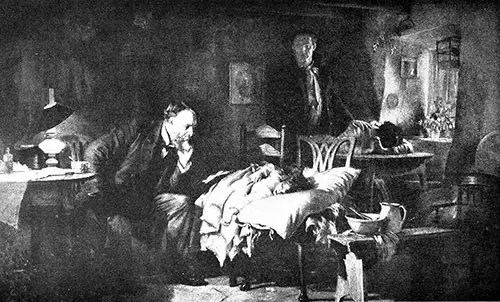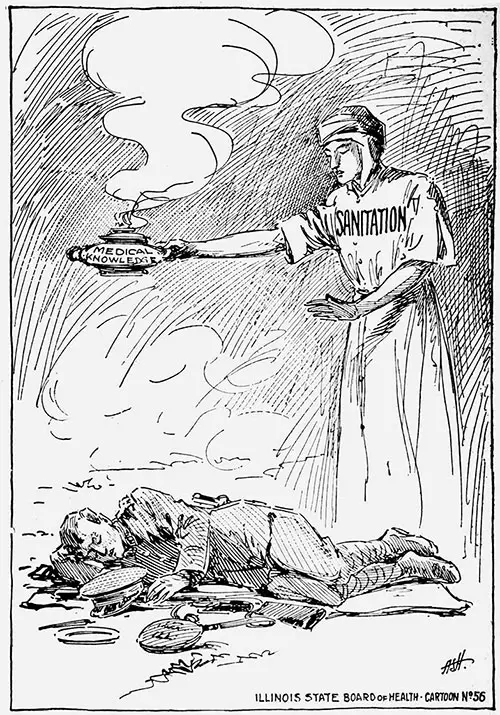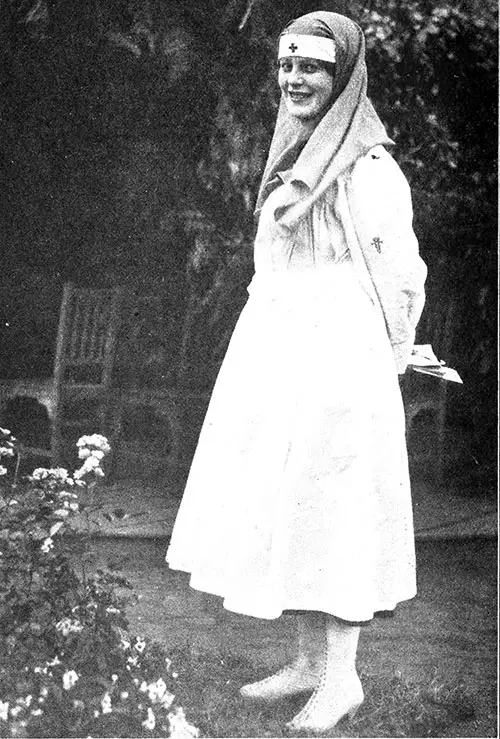Spanish influenza Pandemic - 1919

The Family Physician. Epidemics: How To Meet Them, 1919. GGA Image ID # 1510a16ca8
Spanish influenza is not a thing of the past. Judging from the history of such epidemics, this latest and most violent of plagues may be expected to return frequently for several years. Col. Victor C. Vaughan, M. D., an ex—president of the American Medical Association, at a meeting of the American Public Health Association, said:
"We are going to have influenza with us; it is not going to disappear very soon. I do not want to be a pessimist; I am always an optimist.
The second year of the epidemic of 1899 showed more deaths from influenza than the first year, and we are going to have the influenza epidemic for some time to come."
The appearance of Spanish influenza in 1918 was of so violent a character as to arouse the people of all lands to the most active effort: in combating its progress. It is said that during the first three months its toll of human life was almost if not quite equal to the fatalities in battle during the entire four years of the Great War.
The publishers of this little book desire to join their fellow men in the fight against these enemies of mankind. It is not published for profit, but to give to as many as possible some practical help in time of need.
Men and women of all communities, therefore, are invited to join in the effort to place this useful book in every home in our land; for it is confidently believed that an intelligent knowledge of how to meet these epidemics will save for future usefulness the lives of many, besides preventing much needless suffering and sorrow.
SPANISH INFLUENZA EPIDEMIC
NEVER in the history of the world, perhaps, has there been an epidemic disease that has been more extensive, that has traveled with greater rapidity, or that has, during so brief a period, been more disastrous in its results, than the disease to which the name Spanish influenza has been given.
It first made its appearance in Spain , thence it spread quickly to other parts of Europe, including Great Britain, and then took a bound across the Atlantic. Beginning its destructive work on this continent in the city of Boston, it spread with remarkable rapidity throughout the United States and Canada, exacting a toll of human life heretofore unheard of in these countries in so short a time.
More Destructive than the Great War
The terrible World War which began in 1914 was regarded as the greatest destroyer of human life ever known, 7,354,000 men in the prime Of life being sacrificed on the field of battle during the four and one-half years of its continuance.

Ignorance Is More Destructive Than War. Illinois State Board of Health Cartoon No. 56. Epidemics: How To Meet Them, 1919. GGA Image ID # 1510b03fe9
No slaughter like it had ever before been witnessed, and yet the epidemic of influenza, which made its appearance near the close of the war, was responsible for almost if not quite as many deaths in less than four months' time.
In the whole world not less than six million persons perished from influenza and its complications during the short space of about three months. Some reports place the number a great deal higher, claiming that in India alone there were six million deaths from influenza.
In some of our American cities whole families were wiped out. In describing the havoc wrought at the cantonments of America, Dr. Victor C. Vaughan said:
"I went to Camp Devens as soon as the epidemic was reported, and I might say that I thought my eyes would never see such horror as I saw there. I went through the Spanish-American War; I saw thousands and thousands of cases of typhoid fever, but I never had anything so depress me as the conditions that existed at Camp Devens."
Many sections of the United States have had more than one visitation of the epidemic, in some instances the second or third being more severe than the first. This has been true also of other countries. Switzerland had two distinct waves. The United States Public Health Reports for April 14, 1919, after giving figures showing the monthly totals of cases, said:
"Here we see again, as was the case in England, two distinct waves, one with its crest in July, the other with its crest in October. The occurrence of these waves in practically all parts of the world where the pandemic prevailed, is most puzzling.
It is difficult to conceive of any external, i.e., environmental, influence acting so uniformly throughout the world; and that the virus should everywhere show these peculiar variations in infectivity and virulence is certainly most remarkable."
The same publication, of April 4, 1919, reported a third wave of influenza hitting England. Thus it is seen that we cannot be sure as to just when the danger from it is over.
In United States Public Health Reports for August 1919, Surgeon W. H. Frost, M. D., gave this additional caution:
"It seems probable that we may expect at least local recurrences [of influenza] in the near future, with an increase over the normal mortality from pneumonia for perhaps several years; and certainly we should be, as far as possible, prepared to meet them by previous organization of forces and measures for attempted prevention, treatment, and scientific investigation."
Other Epidemics Coming
The great European war is at an end, for a time at least, but the germs of influenza have not yet surrendered. Other epidemics are likely to occur, the severity of which will, in all probability, be much greater.

American Red Cross Nurse. Ability to Minister to the Sick Tenderly and Intelligently Is One of the Beautiful Accomplishments of Women. © Keystone View Company. Epidemics: How To Meet Them. GGA Image ID # 1510e98783
The recent epidemic came on the heels of the war and food shortage, when the vitality of the human race was at a low ebb. War, famine, and pestilence are always associated. One follows the other in the order named.
Science has made remarkable strides during the past century. The diseases which proved such a scourge in the past have been practically eliminated. It would be considered a disgrace to any civilized community to have an epidemic of smallpox, cholera, or yellow fever.
We pride ourselves upon our success in eradicating these diseases. So hopeful have some been of the future that a Western editor said:
"If science continues to advance in her efforts as it has during the past few decades, the time will come when undertakers will be compelled to move to a. sicklier planet in order to carry forward their business."
But just as we feel we have made the world secure from epidemic diseases, the greatest epidemic the world has ever seen makes its appearance, and before it we stand as helpless as did the people of two centuries ago before the epidemics of their day.
The same security was felt in regard to a world war. Just before the War broke out, a large body of influential people from all parts of the world were assembled in Europe discussing peace problems. They voiced the general feeling of the people everywhere at that time, when they reasoned, as stated by one of the members: - -
"A great war, a world war, is absurd. It is unthinkable. It is impossible."
While they were discussing these matters, the war broke out, and the peace conference "came to an abrupt end." An ancient seer, looking forward to this time, exclaimed, "We looked for peace, but no good came; and for a time of health, and behold trouble." Jer. 8: 15.
Biblical Forecast
The apostle Paul, referring to this same period in the world's history, declared: "When they shall say, Peace and safety; then sudden destruction cometh upon them, . . . and they shall not escape." 1 These. 5: 3.
Jesus, in answer to the question, "What shall be the sign of Thy coming, and of the end of the world? " replied, "Nation shall rise against nation, and kingdom against kingdom: and there shall be famines, and pestilences. . . . All these are the beginning of sorrows." Matt. 24: 3-8.
These wars, famine's, and pestilences, horrible as they have been, He said, are merely "the beginning of sorrows" that will not end until He comes again. This is not a promising outlook from the world's viewpoint.
While the outlook is bad, very bad, the up look is good, very good. Referring to this time When there was to be "distress of nations, with perplexity," "men's hearts failing them for fear, and for looking after those things which are coming on the earth," Jesus said, "When these things begin to come to pass, then look up, and lift up your heads; for your redemption draweth nigh." Luke 21: 25-28.
That we are in the very midst of these things no one can doubt. Clemenceau said,
"It is a mistake to say the war is over; there is merely a lull in the storm."
This statement harmonizes with the prediction of Christ. We may look for more war, more famine, more pestilence.
Cause Leads to Effect
The epidemic Of Spanish influenza had its origin among the poorly fed peoples of Europe. Lowered vitality, resulting from the scarcity of food, paved the way for the epidemic.
It prepared the body soil for the seeds of disease. No doubt the prevalent use of cigarettes in the cantonments of America had much the same influence upon the young men who were housed there. The mortality was twice as great among them as among the civilian population of the same age, namely, from twenty to thirty-five years.
Any practice, whatever it may be, that impairs the health and lowers vital resistance, paves the way for sickness and death. So long as these predisposing causes exist, we cannot hope for an abatement of epidemic diseases.
Wrong Habits Invite Epidemics
The chief factor in the prevention of epidemic diseases is the building up of the barriers of body defense against invading germs, whatever they may be.
The fact is that for years the people of the world have been preparing the way for the influenza epidemic.
It is well known that many of the habits of men and women have not been conducive to health. Heretofore, epidemics have weeded out the physically Weak, those of lowered bodily resistance.
As the causes of epidemics have been ascertained, every precaution has been taken to prevent the spread of the germs, or seeds, of disease.
By doing this we have kept alive the vitally weak, who before were weeded out; and these have married and intermarried and have produced their kind. The result has been that the vitality of the race as a whole has been weakened.
We know something about the long list of epidemic diseases of the past, but Spanish influenza is a disease that has so far baffled modern science. We know little or nothing about its origin or cause, and hence we stand before it as helpless as did the people of two centuries ago before smallpox, cholera, yellow fever, the plague, and other epidemics.
Dr. Victor C. Vaughan said:
"If I were asked to define influenza, I should say it is a disease of unknown origin."
"So far as the prevention of the respiratory diseases is concerned, we do not know anything more than our ancestors knew a hundred years ago, and we may as well admit it. I say that in the face of the greatest pestilence that has ever struck our country, we are just as ignorant as the Florentines were with the plague described in history."
In summing up the discussion of members of the Public Health Association at the meeting held in Chicago, the editor of the Journal of the American Medical Association said:
"The discussions relative to the etiology [general and specific causes] of the present epidemic resolve themselves into the belief that the actual cause is as yet unknown. "
End Notes (GG Archives)
A misconception as the countries directly involved in the First World War did not publicize their fight with the influenza pandemic of 1918-1919 with censorship of the media. Spain remained neutral during the war and did not suppress the reporting of influenza, thereby creating the false notion that it originated in Spain.
This statement was related to the Eugenics Movements, popular during this time. Eugenics was the study of how to arrange reproduction within a human population to increase the occurrence of heritable characteristics regarded as desirable. Primarily developed by Francis Galton as a method of improving the human race, it fell into disfavor only after the perversion of its doctrines by the Third Reich.
Louis A. Hansen, et al, "Spanish Influenza" in Epidemics: How to Meet Them, Mountain View, CA: Pacific Press Publishing Association, © 1919 Review and Herald Publishing Association, Washington, DC, pp 7-14.
